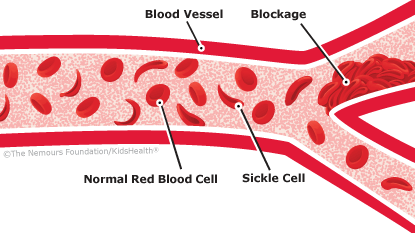Sickle Cell Disease Factsheet (for Schools)
What Teachers Should Know
Sickle cell disease is an inherited disorder of the red blood cells.
In sickle cell disease, the red blood cells become distorted and look C-shaped, like a sickle. Sickle cells die early, which leads to anemia. Signs of anemia include:
- pale skin
- tiring easily
- feeling lightheaded, dizzy, of short of breath
- trouble paying attention
- fast heartrate
Also, these sickle-shaped blood cells tend to get stuck in narrow blood vessels and clog blood flow. This can cause severe pain and organ damage. People with sickle cell disease are at risk for some bacterial infections.

Students with sickle cell disease may:
- need to go to the school nurse’s office and take medicine to help manage pain
- need to drink water throughout the day to avoid dehydration, which increases sickling of red blood cells
- be tired in class and need occasional rests from classroom activities
- need to have classroom air temperature adjusted to avoid becoming overheated or too cold, which can trigger episodes of pain
- have symptoms that need immediate medical care, such as:
- severe pain
- chest pain
- trouble breathing
- fever
- jaundice or paleness
- extreme tiredness
- swelling of hands and feet
- severe headaches
- seizures
- other neurologic symptoms (such as sudden vision changes, slurred speech, weakness or inability to move a part of the body, or loss of consciousness)
What Teachers Can Do
Students with sickle cell disease may miss class time or be absent for doctor visits or hospital stays. Give these students special consideration regarding missed instruction, assignments, and testing.
Chronic fatigue or pain can make it appear that students aren’t motivated to learn. Knowing your students well can help you make an accurate assessment.
Kids and teens with sickle cell disease may not be able to play contact sports or participate in strenuous exercise — check with their parents. Otherwise, encourage them to participate in moderate physical exercise and other school activities.
Let your student carry a bottle of water and take bathroom breaks. Allow breaks from instruction and activities when necessary. Avoid outdoor activities when it’s very hot or very cold.
Be prepared in case a student has any symptoms that need medical care right away.
